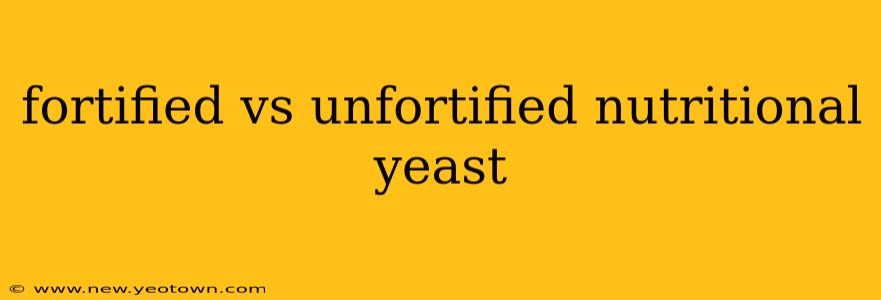Nutritional yeast, that cheesy, nutty, and slightly savory powder, has become a pantry staple for many health-conscious individuals. But did you know there's a key difference between fortified and unfortified versions? This seemingly small distinction can significantly impact the nutritional value you're getting. Let's unravel the mystery and explore what sets these two types apart.
My name is Alex, and I've been a health and nutrition enthusiast for over a decade. I've spent countless hours researching various superfoods, and nutritional yeast consistently stands out for its versatility and nutritional benefits. In this post, we’ll delve into the specifics of fortified and unfortified nutritional yeast, comparing their nutritional profiles and helping you make informed choices for your dietary needs.
What is Nutritional Yeast?
Before diving into the fortified vs. unfortified debate, let's establish a baseline understanding. Nutritional yeast is a deactivated yeast—meaning it's been heated to prevent it from rising—grown on molasses. It's a complete protein, meaning it contains all nine essential amino acids. It's also naturally rich in B vitamins, fiber, and minerals. Its unique, cheesy flavor makes it a fantastic alternative to cheese in many dishes, adding a savory depth to soups, sauces, popcorn, and more.
Fortified Nutritional Yeast: A Nutritional Powerhouse
Fortified nutritional yeast is the star of the show, boasting an impressive nutritional profile boosted by added vitamins and minerals. The most common additions are vitamin B12, which is crucial for vegetarians and vegans, and zinc.
Why is B12 added? Vitamin B12 is primarily found in animal products, making it a common deficiency in plant-based diets. Adding B12 to nutritional yeast makes it a convenient and readily available source for vegans and vegetarians, supporting healthy nerve function and red blood cell formation.
What about the zinc? Zinc plays a vital role in immune function, wound healing, and cell growth. Fortified nutritional yeast provides a significant boost to your daily zinc intake.
Other nutrients may be fortified as well, depending on the brand. Always check the nutritional label to see the complete vitamin and mineral profile.
Unfortified Nutritional Yeast: Still a Valuable Food Source
Don't dismiss unfortified nutritional yeast! While it lacks the added vitamins and minerals of its fortified counterpart, it still delivers a solid dose of nutrients naturally present in the yeast itself. You'll still get a good amount of B vitamins (though not B12), fiber, and other minerals. It’s a great choice if you're already getting sufficient B12 and zinc from other sources in your diet.
What are the Key Differences Between Fortified and Unfortified Nutritional Yeast?
This section directly addresses a frequently asked question: What is the difference between fortified and unfortified nutritional yeast?
The primary difference lies in the added nutrients. Fortified nutritional yeast has added vitamins and minerals, typically B12 and zinc, significantly boosting its nutritional value, particularly for those following a vegan or vegetarian diet. Unfortified nutritional yeast relies on its naturally occurring nutrients.
Is Fortified Nutritional Yeast Better?
The "better" choice depends entirely on your individual needs and dietary preferences.
- For vegans and vegetarians: Fortified nutritional yeast is often preferable due to the added B12, a nutrient crucial for their health.
- Those with B12 or zinc deficiencies: Fortified nutritional yeast can help close the nutritional gap.
- Individuals with diverse diets: If you consume a variety of foods including animal products or other sources of B12 and zinc, unfortified nutritional yeast can be a great, cost-effective option.
How to Choose the Right Nutritional Yeast for You
Selecting the right type of nutritional yeast involves considering your dietary needs and preferences:
- Check the label: Carefully examine the nutritional information panel. Look for "fortified" or a listing of added vitamins and minerals.
- Consider your diet: If you're vegan or vegetarian, or have concerns about B12 or zinc deficiency, fortified nutritional yeast is likely the better choice.
- Taste test: While nutritional profiles differ, there can be subtle differences in taste between fortified and unfortified varieties. Try both to see which you prefer.
- Budget: Unfortified nutritional yeast is often more affordable.
Conclusion: Making an Informed Choice
Both fortified and unfortified nutritional yeast offer valuable nutritional benefits. The best choice hinges on your individual dietary needs and preferences. By understanding the differences between these two types, you can make an informed decision to maximize the nutritional value you receive from this versatile and flavorful superfood. Remember to always check the nutrition label to understand the specific nutritional content of the product you choose.

